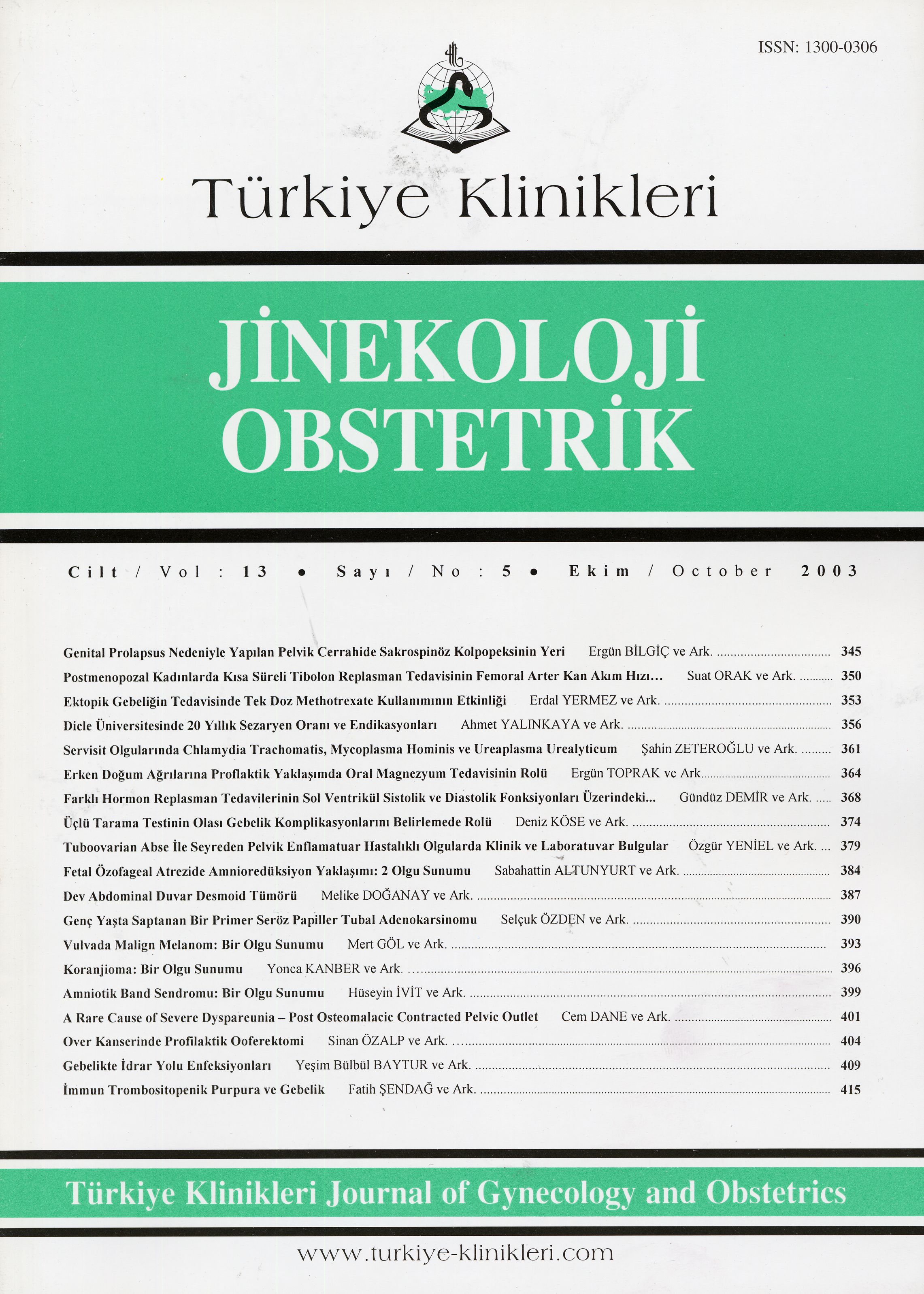Open Access
Peer Reviewed
ARTICLES
3335 Viewed1189 Downloaded
The Role Of Triple Test In Determining The Pregnancy Complications
Üçlü Tarama Testinin Olası GebelikKomplikasyonlarını Belirlemede Rolü
Turkiye Klinikleri J Gynecol Obst. 2003;13(5):374-8
Article Language: TR
Copyright Ⓒ 2025 by Türkiye Klinikleri. This is an open access article under the CC BY-NC-ND license (http://creativecommons.org/licenses/by-nc-nd/4.0/)
ÖZET
Amaç: Maternal serum AFP, hCG ve Östriolün anormal düzeyleri ile gebelik komplikasyonları arasındaki ilişkiyi araştırmak.Materyal ve Metodlar: Nisan 2000-Ekim 2001 tarihleri arasında Zeynep Kamil Kadın ve Çocuk Hastalıkları Eğitim ve Araştırma Hastanesi gebe izlem polikliniğine başvuran 16-20. gebelik haftaları arasındaki 415 gebe çalışmaya dahil edildi. Serum belirteç seviyeleri normal olan 306 gebe (%73.8) kontrol grubuna, en az bir belirteci eşik değerin dışında olan 109 gebe (%26.2) ise çalışma grubuna alındı. Yüksek serum belirteç seviyeleri için eşik değer 2.0 MoM, düşük serum belirteç seviyeleri için eşik değer 0.5 MoM olarak kabul edildi.Bulgular: Kontrol grubunda preeklampsi, erken doğum, İUGG ve fetal kayıp görülme oranları sırası ile %5.2, %4.6, %7.2 ve %0.7 olarak saptanırken çalışma grubunda bu oranlar %12.8, %9.1, %14.7 ve %2.8 olarak tespit edildi. Serum hCG seviyeleri >2 MoM olan 48 (%11.6) gebede İUGG oranı %20.8 (p<0,01) olarak saptandı. AFP seviyeleri >2 MoM olan 8 gebenin 2sinde (%25) preeklampsi (p<0,05), 2sinde (%25) erken doğum (p<0,05), 2sinde (%25) ölü doğum (p<0,01) görüldü. HCG <0.5 MoM saptanan 31 gebenin 4ünde (%12.9) erken doğum gerçekleşti (p<0,05). uE3 <0.5 MoM olan 7 gebenin 2sinde (%28,6) preeklampsi (p<0,01) gelişti.Sonuç: Açıklanamayan anormal MS-AFP, HCG ve uE3 seviyeleri olan hastalar istenmeyen gebelik sonuçlarının görülme olasılığı yönünden yüksek riskli olarak değerlendirilmeli ve bu gruba yakın obstetrik takip önerilmelidir.
Amaç: Maternal serum AFP, hCG ve Östriolün anormal düzeyleri ile gebelik komplikasyonları arasındaki ilişkiyi araştırmak.Materyal ve Metodlar: Nisan 2000-Ekim 2001 tarihleri arasında Zeynep Kamil Kadın ve Çocuk Hastalıkları Eğitim ve Araştırma Hastanesi gebe izlem polikliniğine başvuran 16-20. gebelik haftaları arasındaki 415 gebe çalışmaya dahil edildi. Serum belirteç seviyeleri normal olan 306 gebe (%73.8) kontrol grubuna, en az bir belirteci eşik değerin dışında olan 109 gebe (%26.2) ise çalışma grubuna alındı. Yüksek serum belirteç seviyeleri için eşik değer 2.0 MoM, düşük serum belirteç seviyeleri için eşik değer 0.5 MoM olarak kabul edildi.Bulgular: Kontrol grubunda preeklampsi, erken doğum, İUGG ve fetal kayıp görülme oranları sırası ile %5.2, %4.6, %7.2 ve %0.7 olarak saptanırken çalışma grubunda bu oranlar %12.8, %9.1, %14.7 ve %2.8 olarak tespit edildi. Serum hCG seviyeleri >2 MoM olan 48 (%11.6) gebede İUGG oranı %20.8 (p<0,01) olarak saptandı. AFP seviyeleri >2 MoM olan 8 gebenin 2sinde (%25) preeklampsi (p<0,05), 2sinde (%25) erken doğum (p<0,05), 2sinde (%25) ölü doğum (p<0,01) görüldü. HCG <0.5 MoM saptanan 31 gebenin 4ünde (%12.9) erken doğum gerçekleşti (p<0,05). uE3 <0.5 MoM olan 7 gebenin 2sinde (%28,6) preeklampsi (p<0,01) gelişti.Sonuç: Açıklanamayan anormal MS-AFP, HCG ve uE3 seviyeleri olan hastalar istenmeyen gebelik sonuçlarının görülme olasılığı yönünden yüksek riskli olarak değerlendirilmeli ve bu gruba yakın obstetrik takip önerilmelidir.
ANAHTAR KELİMELER: HCG, AFP, uE3, Gebelik komplikasyonları
ABSTRACT
Objective: To investigate the relationship between the abnormal levels of maternal serum AFP, HCG, E3 and pregnancy complications.Materials and Methods: Four hundred and fifteen women who were 16-20 week pregnant, were enrolled in this study between April 2000 and October 2001 at Zeynep Kamil Women and Children Education and Research Hospital. Three hundred and six (73.8%) pregnant women of whom serum marker levels were normal were included in the control group and 109 (26.2%) in the study group that at least one marker was out of normal range. 2.0 and 0.5 MoM were considered as the normal serum marker limits.Results: For the control group the percentages of preeclampsia, preterm labor, IUGR and fetal demise were 5.2, 4.6, 7.2, and 0.7 % respectively, while the percentages were 12.8, 9.1, 14.7, 2.8 % respectively in the study group. In a group of 48 pregnant women (11.6%) that HCG levels exceeding 2.0 MoM, the rate of IUGR was 20.8% (p<0.01). Among the women of AFP >2.0 MoM, preeclampsi was seen in 2 (25%, p<0.05), preterm labor in 2 (25%, p<0.05) and fetal demise in 2 patients (25%, p<0.01). In 31 patients who had serum HCG levels were <0.5 MoM, 4 of them had preterm labor (12.9%, p<0.05). Preeclampsia had developed in 2 (28.6%, p<0.01) out of 7 patients whose E3 levels were lower than 0.5 MoM. Conclusions: The patient that have unexplained abnormal AFP, HCG, E3 levels should be considered as high risk pregnants and they should be recommended close obstetrical care
Objective: To investigate the relationship between the abnormal levels of maternal serum AFP, HCG, E3 and pregnancy complications.Materials and Methods: Four hundred and fifteen women who were 16-20 week pregnant, were enrolled in this study between April 2000 and October 2001 at Zeynep Kamil Women and Children Education and Research Hospital. Three hundred and six (73.8%) pregnant women of whom serum marker levels were normal were included in the control group and 109 (26.2%) in the study group that at least one marker was out of normal range. 2.0 and 0.5 MoM were considered as the normal serum marker limits.Results: For the control group the percentages of preeclampsia, preterm labor, IUGR and fetal demise were 5.2, 4.6, 7.2, and 0.7 % respectively, while the percentages were 12.8, 9.1, 14.7, 2.8 % respectively in the study group. In a group of 48 pregnant women (11.6%) that HCG levels exceeding 2.0 MoM, the rate of IUGR was 20.8% (p<0.01). Among the women of AFP >2.0 MoM, preeclampsi was seen in 2 (25%, p<0.05), preterm labor in 2 (25%, p<0.05) and fetal demise in 2 patients (25%, p<0.01). In 31 patients who had serum HCG levels were <0.5 MoM, 4 of them had preterm labor (12.9%, p<0.05). Preeclampsia had developed in 2 (28.6%, p<0.01) out of 7 patients whose E3 levels were lower than 0.5 MoM. Conclusions: The patient that have unexplained abnormal AFP, HCG, E3 levels should be considered as high risk pregnants and they should be recommended close obstetrical care
MENU
POPULAR ARTICLES
MOST DOWNLOADED ARTICLES





This journal is licensed under a Creative Commons Attribution-NonCommercial-NoDerivatives 4.0 International License.










